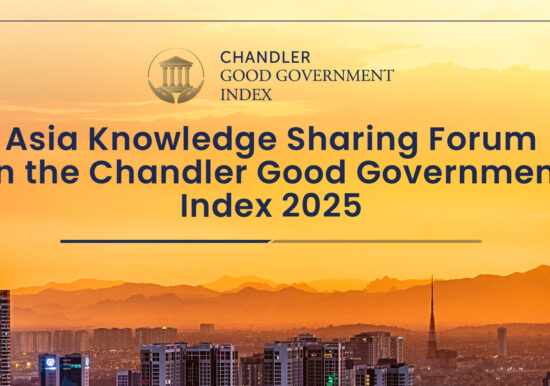
Top Performers & Rising Stars
Looking ahead: who will win the governance competition?
Good government is the deciding factor in whether a nation succeeds. Strengthening government is an iterative, long-term endeavour which can take years and even decades to bear fruit.
In compiling the CGGI over the past four years, we have seen some countries and regions making discernible progress in building capabilities and delivering better outcomes over time. In this section we highlight some of these movements and go beneath the surface of the data to see what might be driving this momentum.1
Regional Reflections
We start by looking at how performance is unfolding at the regional level.2
CGGI Scores (Regional Averages) from 2021 to 2024

Our first observation is that regional average CGGI scores fall into four distinct bands (see next page). In addition, we note that the average scores at the regional level have been relatively steady over time. This is intuitive, given that capabilities take time to develop.
A striking exception is the East Asia region, where the average score has been improving over the past four years.
Second, in the highest-scoring Band 1, both Western Europe and Australia & New Zealand show a small gradual decline in overall performance. Northern Europe is the only region in this high-performing cluster to show an overall improvement over the four-year period. At the lower end of the chart, both South Asia and Sub-Saharan Africa also exhibit declining performances.

Why is East Asia on the up?
The East Asia regional grouping comprises four countries: China, Japan, Mongolia, and South Korea.
Improvement in the East Asia region has been relatively broad-based. Between 2021 and 2024, the region—on average—has improved in five out of seven pillars with slight declines in the other two pillars. The improvement was particularly significant in two pillars, Attractive Marketplace and Leadership & Foresight, both of which have seen consistent year-on-year improvements.
China and Mongolia have been the main drivers for the region’s performance improvements, whereas Japan’s and South Korea’s performance have been relatively stable, with South Korea slightly improving in rank. China’s scores in the Leadership & Foresight pillar have been especially significant, as shown shaded in the stacked bar chart below. It has also demonstrated clear improvements in the Attractive Marketplace pillar and the Helping People Rise pillar. Mongolia has had notable improvement in the Attractive Marketplace and the Financial Stewardship pillars.
CGGI Scores (By Pillar) of Countries in East Asia, 2021 to 2024

Crunching Country Performance
In 2024, nine new countries have been added to the CGGI. One of these, Luxembourg, has gone straight into 7th place in the overall rankings. The addition of new countries partly explains why countries such as Japan have fallen out of the Top 20, and why other countries have fallen several places, particularly in the lower half of the table.
Nevertheless, when comparing country performance between 2021 and 2024, Index scores overall are remarkably stable, as shown below.
From this chart, we can also see a bifurcation in performance: the biggest improvers come almost entirely from the top half of countries in the CGGI rankings, whereas those countries that saw the largest declines came from the bottom half.
Put differently—it appears that the better performers are getting better, whereas the worst performers are slipping further. It is too early to tell if this will be a trend into the future—but if it does continue, it could worsen the disparity in the quality of governance across the world.
CGGI Overall Scores 2021 vs. 2024 and the Top 20 Movers

Improved performance in the Index is emerging in different corners of the globe.4 Here, we take a more detailed look at four countries that have shown breakaway performances over the past four years.
Greece gets the prize for the highest overall improvement in score over the four-year period. Its rank has also jumped from 50th to 41st. Scores improved across six pillars, with remarkable gains in the Leadership & Foresight, Strong Institutions, and Attractive Marketplace pillars. The country has made noteworthy advancements in building up diverse capabilities, as seen in indicators such as Adaptability and Quality of Judiciary, and in outcomes such as the Social Mobility indicator. The Economist magazine naming Greece as its “Country of the Year” for 2023, noting: “Greece shows that from the verge of collapse it is possible to enact tough, sensible economic reforms, rebuild the social contract, exhibit restrained patriotism—and still win elections.”5
The UAE has made consistent year-on-year improvements across six CGGI pillars. It has made the best improvement in overall CGGI rank, jumping from 24th to 14th. This is particularly remarkable given the strong governance competition shown in the table. UAE has made big improvements in four out of seven pillars: Leadership & Foresight, Strong Institutions, Financial Stewardship, and Global Influence & Reputation. The UAE has also made big strides in indicators that include Strategic Prioritisation, Implementation, and Nation Brand.
Uruguay has inched up the overall rankings from 33rd to 31st. But delving further we see how the country has in fact leapfrogged 20 places, from 27th to 7th, in the Leadership & Foresight pillar with impressive rises in the indicators for Long–Term Vision and Adaptability. It has also risen across the Attractive Marketplace pillar with improved Property Rights, Macroeconomic Environment, and Stable Business Regulations indicators.
Rounding out the group is Vietnam, with consistent year-on-year improvements in four pillars and an improvement in rankings from 58th to 50th. Much has been written in the media about the country’s increasingly Attractive Marketplace and this is supported with improved indicators for Property Rights and Stable Business Regulations, amongst others. Some of its strongest gains are in the Leadership & Foresight pillar with a jump in rankings from 61st to 28th. These capability gains are also translating into good outcomes for citizens with improvement in the indicators for Satisfaction with Public Services and Income Distribution.
In future, we look forward to seeing how CGGI time-series data can build up an even more nuanced and storied picture of governance “Top Performers and Rising Stars” across the globe.
CGGI Scores (By Pillar) of Selected Countries with Notable Improvements, 2021, to 2024

Endnotes
- For year-on-year comparability, this analysis only covers the 104 countries listed in the CGGI since 2021. The nine new countries added in 2024 are not included in the regional groupings.
- The regional classifications used in this commentary are based on the United Nation’s M49 standard (https://unstats.un.org/unsd/methodology/m49/) and World Bank (https://data.worldbank.org/country). A full list of these regional groupings can be found in Appendix 1, on page 122 of this Report.
- “Significant improvement” means an increase in score of over 0.05 in a given pillar (0-1 scale).
- Other countries in the top ten for improvers in overall score from 2021 to 2024, and that should be recognised, are: Italy, China, Mongolia, Lithuania, Singapore, and Georgia.
- The Economist. (2023, December 20). The Economist’s country of the year for 2023. https://www.economist.com/leaders/2023/12/20/the-economists-country-of-the-year-for-2023
- “Significant improvement” means an increase in score of over 0.05 in a given pillar (0-1 scale).
More Stories


Watch the Chandler Good Government Index 2025 Regional Launch

